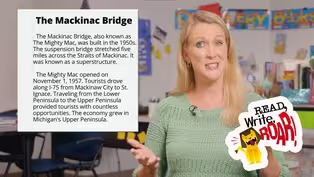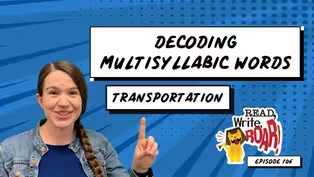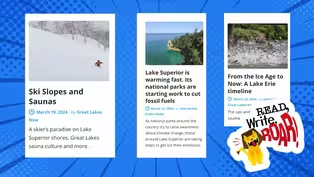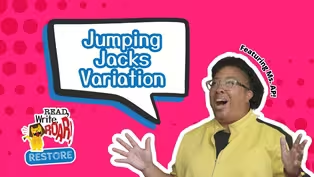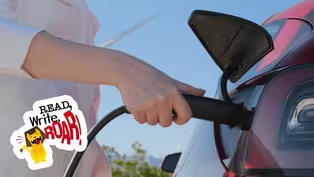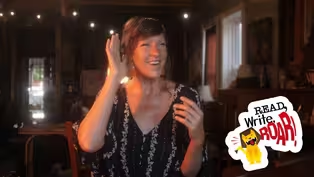Read, Write, ROAR!
Getting From Here to There - Michigan's Bridges, Roads, Waterways, and More
Season 1 Episode 1005 | 26m 46sVideo has Closed Captions
Learn about how transportation works in Michigan.
From bridges to roads, rivers to lakes, trains to planes Michiganders need to get from here to there. Learn about how transportation works in Michigan.
Problems playing video? | Closed Captioning Feedback
Problems playing video? | Closed Captioning Feedback
Read, Write, ROAR! is a local public television program presented by Detroit PBS
Read, Write, ROAR!
Getting From Here to There - Michigan's Bridges, Roads, Waterways, and More
Season 1 Episode 1005 | 26m 46sVideo has Closed Captions
From bridges to roads, rivers to lakes, trains to planes Michiganders need to get from here to there. Learn about how transportation works in Michigan.
Problems playing video? | Closed Captioning Feedback
How to Watch Read, Write, ROAR!
Read, Write, ROAR! is available to stream on pbs.org and the free PBS App, available on iPhone, Apple TV, Android TV, Android smartphones, Amazon Fire TV, Amazon Fire Tablet, Roku, Samsung Smart TV, and Vizio.
Providing Support for PBS.org
Learn Moreabout PBS online sponsorship- On "Read, Write, ROAR!," from bridges to roads, rivers to lakes, trains to planes, Michiganders need to get from here to there.
Learn about how transportation works in Michigan.
Let's go.
"Read, Write, ROAR!"
- [Announcer] This program is made possible in part by the state of Michigan and by... And by viewers like you.
Thank you.
(upbeat music) - Imagine two pieces of land separated by miles of water.
How would you connect them?
That is a problem real engineers had to solve to connect Michigan's Lower and Upper Peninsulas.
I'm Mrs. DaFauw, and today I want to learn with all of you about how the Mackinac Bridge was built from 1950 to 1960.
Before we learn all about the Mackinac Bridge, we need to know what a peninsula is because Michigan is made of two of them.
A peninsula is a piece of land almost surrounded by water.
Because Michigan's southern shore of the Upper Peninsula and the northern shore of the Lower Peninsula were separated by Lake Michigan to the west and Lake Huron to the east, engineers needed to figure out how to build a bridge to connect these two peninsulas.
Even before I jump into my reading, I know that engineers had to choose to use the tools available to them like hammers, wrenches, screwdrivers, and drills.
All of these tools are sitting right here in front of me.
But once I learn how these tools work, I have to choose to pick them up and use them.
The same is true for us as readers.
We choose to use our decoding strategies as tools to help us build our comprehension so we understand what we read.
Today, we are going to read a passage with words that have many syllables.
When words have around three or more syllables, we call them multisyllabic words because multiple means many.
It can be tricky to read multisyllabic words, so we are going to learn how to decode those words to support our comprehension.
Just like the Mackinac Bridge connects Michigan's Upper and Lower Peninsulas, we are going to learn how to build a bridge of understanding from the words we read on the page to our brains where all our learning takes place.
I've been researching the Mackinac Bridge and wrote a paragraph based on my research from the following sources.
Let's read this passage together, which is missing some multisyllabic words.
The Mackinac Bridge, also known as the Mighty Mac, was built in the 1950s.
The.... Bridge stretched five miles across the Straits of Mackinac.
It was known as a...
The Mighty Mac opened on November 1st, 1957.
Tourists drove along I-75 from Mackinac City to St. Ignace.
Traveling from the Lower... To the Upper...
Provided tourists with countless opportunities.
The economy grew in Michigan's Upper... Skipping all those words is confusing.
I don't understand what we read.
I bet you can guess some of those words based on what we've already discussed today.
When we read from the Lower to the Upper, what's your guess?
Right.
Peninsula.
Good guess!
But let's not guess when we read.
Guessing is like using a screwdriver when you need a hammer.
It might get the job done, but there's a better tool to use.
Let's decode this word together.
Since every syllable or word part has a vowel.
Let's break up this word.
There are four vowels, e, i, u, and a.
So I anticipate there will be four parts.
Pen, in, su, la.
Let's read the word together, peninsula.
Rather than guessing, we must use our tools as readers to decode multisyllabic words.
To decode peninsula, we used a flexible decoding tool.
We have many tools to help us decode, but if we choose to not use those tools, reading is going to be harder, if not impossible.
Let's use our decoding strategies to read some more multisyllabic words.
I've put back into the text, because without those words, we can't comprehend what this paragraph is about.
Let's decode this word using a covert strategy, which is like going on a secret mission to decode a word.
First look for affixes, which are word parts that hold meaning.
Two affixes we need to look for are prefixes at the beginning of a word and suffixes at the end of a word.
Are there any word parts or affixes we already know?
I know sion is a suffix, which means state up.
I don't see a prefix at the beginning, but I do see two vowels, u and e. This helps me to know I have two additional parts or syllables to decode, sus, pen, sion.
Let's read the word together, suspension.
A suspension bridge is a type of bridge that has a roadway hanging from many cables that are anchored at the ends.
Now, let's read this word.
Are there any word parts we already know?
Super jumps out at me, and I also see the word structure.
Because this word has two words, super, structure, it's a compound word.
Once I use this strategy to break it up into two smaller words, it's easier for me read.
It's important to decode.
It's also important to understand.
Super reminds me of superheroes, so I understand that part of the compound word.
I also know that another name for the Mackinac Bridge is Mighty Mac, which sounds like a superhero's name.
Structure means building or construction.
With the Mighty Mac stretching five miles across the water it sure is a super structure.
As readers, we are a lot like the people who had to choose to use the tools available to them, to build the bridge.
The Mackinac Bridge would never have stretched from the Lower Peninsula to the Upper Peninsula without people who use their tools.
As readers, we have the tools that help us decode multisyllabic words.
So keep building your reading skills by using what's in your toolbox.
(gentle music) - I am Ms. AP, here to help restore your energy.
Let's start with our warm up.
We are gonna be running in place by the count of 10.
Ready?
Go.
1, 2, 3, 4, 5, 6, 7, 8, 9, 10.
Good job, everyone!
Now that we have warmed up our bodies, we are ready to exercise.
Today, we are going to work on combining movements with our arms and our legs.
I would like you to use your ready position standing up tall like a pencil, arms at your thighs, with your feet together.
Once your body's in that ready position, we're gonna jump out, arms out and up, jump in, arms down.
Good.
That was one whole jumping jack.
Let's try that again a little bit faster.
Ready position, jump out, arms out, jump in, arms down.
Awesome.
Now, let's try 20 jumping jacks together.
Ready, set, go!
1, 2, 3, 4, 5, 6.
13, 14, 15, 16, 17, 18, 19, 20.
Good job.
Give yourselves a big clap, clap.
(clapping) Wow!
Nice job.
Let's start cool down.
Breathe in and breathe out.
Breathe in and breathe out.
Great job.
(upbeat music) - Do you ever find complicated words while you're reading?
I know I do.
I'm Mrs. Mora.
Today, we'll learn to use word parts like prefixes and suffixes to read unknown words.
Recently, I've been reading about traveling, bridges and trains and bicycles.
And I've come across some difficult words.
Here's a word.
First, let's circle the prefixes.
A prefix is a word part added to the beginning of a word to change its meaning.
Is there a prefix in this word?
It's trans.
Trans usually means across or beyond.
Now, let's circle the suffixes.
A suffix is a word part added to the end of a word to change its meaning.
Do you see a suffix?
We see this part, ation.
Ation combines the suffixes, a-t-e and i-o-n.
It's often added to the end of a verb to make a noun that names an action or process.
Next, let's mark the vowels in the root or base word.
Vowels help us break words into syllables.
Each syllable can have only one vowel sound.
Which vowels do you see here?
We see o and r, which work together to form the r-controlled vowel sound, or since there is one vowel sound, we expect to find one syllable in this middle part.
Here, port is a root word that means to carry or bring.
Let's say the word parts.
Trans, por, ta, tion.
Now, let's say the whole word, transportation.
Is that a real word?
It is.
Since this is a real word, we're finished.
Transportation is the act of carrying or moving something across a distance.
Like a car transporting people across the Mackinac Bridge in Michigan.
If you speak Spanish, words like transporte or transportacion can help you understand this word.
Here's another word.
First, let's circle the prefixes.
Do you see a prefix?
Maybe not a prefix that we know.
So let's circle the suffixes.
What do you see?
We see this part, ation, again.
Now, let's mark the vowels.
What do you see?
e and i.
Remember, each syllable can only have one vowel sound.
So let's separate these vowel sounds between the consonants, s and t. Let's say the word parts, des, ti, na, tion.
Now, let's say the whole word, destination.
Is that a real word?
It is.
Since we know this is a real word, we're finished.
The word destine can mean to send something toward a certain place or purpose.
So the word destination is a place to which something is going or being sent.
If you travel north on the Mackinac Bridge, your destination may be in the Upper Peninsula.
If you speak Spanish, the word destino could help you understand this word.
Great work today!
Keep reading and try the strategy the next time you find a challenging word.
- Have you heard about EVs or electric vehicles?
They may seem new to our roadways, but what if I told you they've been around for over 100 years?
Hi, learners.
I'm Mrs.
Mask.
And yes, it's true.
Electric vehicles have been around since the mid-1800s.
As we learn more about EVs, I'll also model or show you how I write short notes about what I read.
Then I'll use my notes and model how to write a summary.
A summary includes the most important ideas from a text and connects them to the central ideas.
Summaries are good to write because they help us better remember what we read.
This article will teach us a lot of interesting things about electric vehicles.
So we want to remember what we discover.
Follow along as I read the first part of the article.
Listen closely, because after I finish reading, we'll list the most important ideas.
The birth of the electric vehicle.
It's hard to pinpoint the invention of the electric car to one inventor or country.
Instead, it was a series of breakthroughs from the battery to the electric motor in the 1800s that led to the first electric vehicle on the road.
In the early part of the century, innovators in Hungary, the Netherlands, and the United States, including a blacksmith from Vermont, began toying with the concept of a battery-powered vehicle and created some of the first small scale electric cars.
While Robert Anderson, a British inventor, developed the first crude electric carriage around this same time, it wasn't until the second half of the 19th century that French and English inventors built some of the first practical electric cars.
Now, as a reader, I need to remember the most important content from this paragraph.
Let's list some important phrases we've learned so far, not just one inventor of the electric car, there was a series of discoveries, and battery-powered in small-scale.
Mid to the late-1800s, which is a 19th century, the first practical usable electric cars were built.
Now, let's continue reading to learn more about the history of electric vehicles.
Here in the US, the first successful electric car made its debut around 1890, thanks to William Morrison, a chemist who lived in Des Moines, Iowa.
His six-passenger vehicle capable of a top speed of 14 miles an hour was little more than an electrified wagon, but it helped spark interest in electric vehicles.
Over the next few years, electric vehicles from different automakers began popping up across the us.
New York City even had a fleet of more than 60 electric taxis.
By 1900, electric cars were at their heyday, accounting for around a third of all vehicles on the road.
During the next 10 years, they continued to show strong sales.
I combine my notes into one document.
There's a lot of notes.
And now I need your help to make my messy notes make sense.
Let's take all of our notes and write a summary together so we don't forget what we learned.
Now, let's think of a sentence we can write that helps to share the ideas we learn.
Let me model this first.
Hmm.
How about electric cars are not new and have been around since the mid to late 1800s, after a series of discoveries led to their invention.
What do you think of that sentence?
Now, let's write one together.
In 1890, the first electric car that could go up to 14 miles an hour was seen in the United States.
It's okay if we didn't use all of our notes to write the summary.
It's important to give correct information, but we don't have to write every detail.
Now, let's write one more sentence to add to the summary.
More automakers begin building electric cars and, soon after, electric cars were about 1/3 of all cars on the road.
Now, let's combine all three sentences as we read the summary together.
Electric cars are not new and have been around since the mid to late 1800s, after a series of discoveries led to their invention.
In 1890, the first electric car that could go up to 14 miles an hour was seen in the United States.
More automakers began building electric cars and, soon after, electric cars were about 1/3 of all cars on the road.
Did we get the most important ideas from the text?
Since we took the main ideas from it, we should be able to remember a quick history of electric vehicles.
Writing summaries can seem like a difficult job, but if you take good notes and really think about what's important, you'll be successful.
As you're learning about new topics, you summarize 'em to share ideas with your friends and family.
(upbeat music) - Hello, friends.
I'm Ms. Audra, and today, we're gonna create the soundtrack for a zoo, and you're gonna help.
So we're gonna think about all the sounds you might hear at a zoo.
The roar of a lion (roaring) or the (rumbling) of the elephant, or the squawking of a bird, or the sound of a seal, (barking) whatever creature, whatever animal you wanna imagine, the slither of a snake sound.
So let's take a breath together and then hold it and then make a sound, maybe it's snake today to blow out, and bring that breath in again.
Then hold.
You can make your slithering snake sound.
(Audra hissing) Think about all those sounds again, and I want you to think of a movement also, elephant or roaring like a lion or even the monkey.
What's your body doing?
What's your hand gonna do?
What's your whole body if you have the space to do so?
And on the count of three, we're all gonna make our sound.
Wherever we are in our group, we're gonna make our sound and make our movement.
Ready?
1, 2, 3.
Keep it going.
Maybe you can get really loud and bring it all up that soundscape.
Build it, build it.
And I'm gonna make my sound.
Ooh, aah, ooh, aah, ooh, aah.
And on the count of three, we're gonna pause together.
1, 2, 3.
Nice job.
Think about how your body feels making all those sounds, and think about all the sounds that were happening in the room for you, and were you able to look at someone else and still make your sound.
As we say goodbye, I'm gonna invite you again to take a deep calming breath to center ourselves.
Here we go.
(inhaling) And just hope and then blow it out like the snake.
(Audra hissing) All right, we'll see you next time.
(upbeat music) - Wow!
The shipwrecks in our great lakes are incredible.
I wonder what it would've been like to sail on one.
Hmm.
(water gurgling) (gentle music) Oh my goodness.
I'm Ms. Kara, and today we're going to learn about text features and news articles.
My friend Media Literacy Maddie, is here to help us while I go change into some dry clothes.
- Hello, scholars.
Today, we're going to take a look at an article written about a great lake shipwreck to help you become more familiar with the text features of the news article.
Some of your families might still get a newspaper delivered to your home, but most people are reading their news digitally these days.
- I love the newspaper, the headlines, the photographs, the interviews, such great information about important stories that impact our communities.
You probably don't wanna watch me read.
Hey, Media Literacy Maddie, we need your help teaching our scholars about the important text features of a news article in order to guide their reading of the article.
- Well, let's get started.
The article we're going to look at is called "Michigan researchers find 1914 shipwrecks in Lake Superior."
If you are reading a book, this would be called a title.
However, in journalism, this is called a headline.
The headline is used to attract the audience's attention.
Did you notice that the font style is bold?
Here's another article.
Do you see the headline?
Usually, the headline is short and it summarizes what the article is about.
Do you have a piece of paper and pencil handy?
Write a short headline about something you saw outside the window of your house.
Great work, everyone!
- My headline was, Ms. Kara Finds Invasive Species.
- Oh, great, Ms. Kara.
Nice.
This article has a photograph or a picture of the ship's hull.
It has some letters that I can't see very well, but when I read the article, I found out right here that the letters are the name of the boat, the Selden E. Marvin.
This link takes you to a video with more information about the shipwreck.
Another important text feature of a news article is the writer of it.
In journalism, the writer is given a byline.
Kathleen Foody of the Associated Press wrote this article and has the byline.
My byline is Ms. Kara, Read, Write, Roar!
Scholars, do you still have your paper and pencil nearby?
What would your byline be if you were writing a news article?
- [Maddie] As you read through the article, you'll notice there are sentences with quotation marks around them.
Quotes show us exactly what an expert on the topic says.
For example, this quote from Corey Adkins says, "One of the things that makes us proud when we discover these things is helping piece the puzzle together of what happened to these 28 people."
Quotes are very important to news articles because they can provide information, direct insight, and perspective by the people involved in the story.
- We've learned so much today about reading a news article.
Scholars, before you go, can you get another piece of paper and draw out the text features of a news article like I did?
Today, we learned how to read a news article by analyzing its text features, headline, byline, quotes, and photograph.
Be on the lookout for these text features the next time you are reading a news article.
- Thank you for watching.
For more episodes, videos, lessons, activity guides, and more, be sure to visit us at our website.
And don't forget, "Read, Write, ROAR!"
(upbeat music) - [Announcer] This program is made possible in part by the state of Michigan and by... And by viewers like you.
Thank you.
(upbeat music) (text chimes)
Decoding Multisyllabic Words With Mrs. DeFauw
Video has Closed Captions
Clip: S1 Ep1005 | 6m 17s | Strengthen your reading skills while learning about the history of the Mackinac Bridge. (6m 17s)
Decoding Words! TRANSPORTATION | Prefixes, Suffixes, and Root Words for Multisyllabic Words
Video has Closed Captions
Clip: S1 Ep1005 | 4m 24s | Prefixes and suffixes can help us understand challenging words related to travel. (4m 24s)
Exploring Great Lakes Shipwrecks: Learning Text Features
Video has Closed Captions
Clip: S1 Ep1005 | 4m 13s | Break down the key features of news articles while uncovering the mystery of a 1914 shipwreck. (4m 13s)
Read, Write, ROAR! Restore - Jumping Jacks Straight Jack Variation
Video has Closed Captions
Clip: S1 Ep1005 | 2m 31s | Take on the jumping jacks challenge with Ms. AP in this quick 2-minute session. (2m 31s)
Summarizing the History of Electric Vehicles
Video has Closed Captions
Clip: S1 Ep1005 | 5m 39s | Learn how to summarize facts while discovering how EVs are shaping the future. (5m 39s)
Zoo Soundscape | Animal Sounds with Ms. Audra
Video has Closed Captions
Clip: S1 Ep1005 | 2m 11s | Roar, squawk, and even slither like a snake as we create the sounds of the zoo. (2m 11s)
Providing Support for PBS.org
Learn Moreabout PBS online sponsorship

- Home and How To

Hit the road in a classic car for a tour through Great Britain with two antiques experts.












Support for PBS provided by:
Read, Write, ROAR! is a local public television program presented by Detroit PBS
